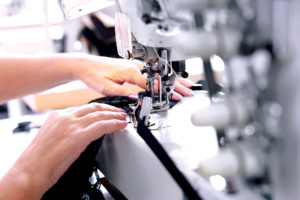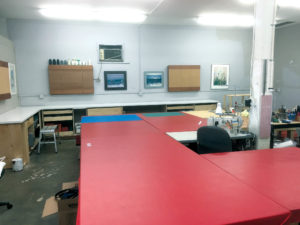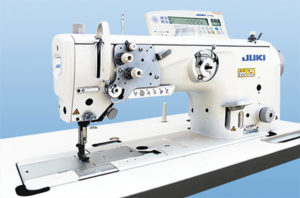Choosing the right sewing machine saves time and money.
 Every trade has its tools, and marine fabrication is no exception. A critically important tool of marine fabrication is the sewing machine. Regardless of the brand, a sewing machine has to be durable, reliable and easily maintained, because it is, after all, the workhorse of a productive shop.
Every trade has its tools, and marine fabrication is no exception. A critically important tool of marine fabrication is the sewing machine. Regardless of the brand, a sewing machine has to be durable, reliable and easily maintained, because it is, after all, the workhorse of a productive shop.
Purchasing a professional-grade sewing machine, however, is an investment, and marine fabricators have many cost factors to consider, whether their business is a start-up or long established.
Start-up challenges
As Rick Balabuck, owner of Good Vibrations Canvas in Marina del Rey, Calif., was developing his canvas business and his sewing skills, he went through a long and painful process of trying to make his marine canvas projects using different types of sewing machines, starting off with a low-cost home Singer machine, then purchasing a semi-professional walking foot machine.
“After a year of struggling with the semi-professional machine, I ended up getting a commercial-quality walking foot machine from a local dealer,” Balabuck says. Eventually, Balabuck did a lot of reading and research in the professional forums as well as attended a training course, which resulted in the purchase of a high-quality Japanese-manufactured walking foot machine, the Juki 1541, from his local dealer.
“My initial concerns were the cost of the machine and, consequently, I did not pay much attention to both the quality of the stitching and the reliability and durability of the sewing machine,” Balabuck says. “In the end, I wasted a lot of time and money on machines that were not strong or reliable enough to produce the quality of work that I wanted to deliver. In effect, I probably spent two to three times the cost of a high-quality machine and wasted a considerable amount of time trying to adjust or fix inadequate machines that simply were not up to the tasks I needed them to do.”
Sewing machine selection
So how do marine fabricators determine the best machine to purchase? Should it be based on interior projects, exterior projects, type of textiles and components to be sewn?
According to Steven Kaplan, owner of S. Kaplan Sewing Machine Co. Inc., Newark, N.J., machine selection should be primarily based on the type of material and thread the fabricator wants to sew, and what type of products the company makes.

“The most common machine our marine shop customers use is a single-needle walking foot machine,” Kaplan says. “New machines of this type start at around $1,100, complete with table and motor.”
Having been in business for 30 years, Ben Lange, owner of Wyoming Canvas in Wyoming, Minn., relies on one double-needle machine and five single-needle machines. “These machines have not changed much in the past 30 years, unless you go into computerized or heat-sealing sewing technology,” Lange says.
According to Calvin Hampton, manager of non-apparel technical services at Juki America Inc. in Doral, Fla., advising the owner of a marine shop on the best machines to purchase should be based on the type of project, type of textiles to be sewn and components involved.
“All aspects of the project should be considered before the purchase,” Hampton says. “For exterior projects, canvas and like textiles would be sewn with a heavy or extra-heavy walking foot sewing machine. For interior projects, materials such as vinyl, leather or upholstery may be used, requiring a medium-to heavy-weight walking foot machine.”
For cottage industry marine shops, Hampton estimates that a machine will cost between $7,000 and $10,000 for a high-quality, full-featured machine.
“It depends on the features needed for the specific applications,” Hampton says.
Factors to consider
When it comes to selecting the ideal sewing machine, there are several factors to consider, including speed, power consumption, type, sound/noise, motor/drive, work space and bed type.
“When I got a professional-quality walking foot machine, I was able to consistently handle the heavy materials and wide variety of products I needed to sew,” Balabuck says. “However, by this time my standards for the quality of stitching had increased. Also, I was seeing a clear need for reliable slow-speed stitching to produce the quality of product that I felt was important. But this was beyond the capability of the machine that I had purchased.”
When Balabuck finally purchased a high-quality machine that was capable of producing reliable and consistent stitching and fabric feeding, it also included the additional key features of slow-speed servo motor control and automatic needle positioning.
“A lot of my problems disappeared and my productivity increased dramatically,” Balabuck says. “When purchasing a machine, I evaluate if it offers reliable feeding with walking foot systems, which have enough power to punch through six to eight layers of Sunbrella® along with .040 vinyl or other plastics like Makrolon®.”
Most of the machines Kaplan sells today come with a variable speed servo motor. “They are exceptionally quiet, and the fabricator can adjust the speed to the particular item being sewn,” Kaplan says. The servo motors consume significantly less power than the older clutch motors. As far as working space, most marine shops will, at some point, want to add a long-arm sewing machine because of the ease with which it allows a fabricator to work with larger pieces of fabric.
“In most cases, marine shops use flat bed sewing machines—a cylinder arm machine, while nice to have, is not needed that often for this type of work,” Kaplan says.
Proper use and maintenance
James Foster, owner of Heber Springs Marine Upholstery in Heber Springs, Ark., says that each type of machine presents a learning curve when it comes to understanding the proper use of the machine and its subsequent maintenance.
“Having grown up in the trade, watching my dad maintain his own equipment, it’s just second nature for me to do the same. However, it’s been my experience that professional marine fabricators are very mechanically inclined,” Foster says. “It’s really one of the basic characteristics that enable us to succeed in our profession.”
Any sewing machine sold at S. Kaplan Sewing Machine Co. comes with a manual, and the company offers free training in its shop with any machine sold.
“Customers will travel quite a distance to take advantage of this,” Kaplan says. “A couple of hours spent here with our mechanics go a long way toward the customer being able to use and maintain their machine efficiently.”
Hampton says the best training should be provided by the company that sells the machine. “In the case of Juki, all authorized distributors are trained by Juki and, in turn, can provide quality training to their customers,” Hampton says.
In their fabrication business, Lange and his team rely on trial and error and lots of practice in the proper use of the machines he owns. “Most sewers began sewing on a Singer by the age of 10. If you don’t learn when you are young and interested, you may lose out on a life skill you can use in many situations,” Lange says. “Professional sewing develops when you enter the field of industry. If you have basic sewing skills, you will have them forever.”
Balabuck is mostly self-taught in the proper use of sewing machines, with one training course from Hood Canvas.
“Unfortunately, I took the training after I had learned the hard way about the importance of having the right tools to work with, the need to slow down and pay attention to details,” Balabuck says.
Of course, maintaining heavily used machines requires Lange to regularly oil his machine, change needles on a weekly basis, depending on the use, and keep the machine free of dust and dirt.
Sew innovative
During the last five years, the biggest single improvement in sewing machine technology has been the use of the servo motor. Kaplan says, “Many of our customers have changed all their machines to use these motors once they try one. Secondly, many of our smaller customers are now taking advantage of such features as needle positioning and under-bed thread trimming on their machines. These features can really improve efficiency, and the price today of these machines is reasonable enough to be within the budget of most fabricators.”

At his small business, which deals with custom covers and repairs, Lange has not seen much change in sewing machine technology at his level. “The next level would be on a larger scale, in which you may incorporate technology. That is not this type of business,” Lange says.
Foster stresses that the two most well-known advancements in industrial sewing machines are the servo-drive motor and the adjustable needle stop position. For Foster, one of the most basic necessities is for a machine to be equipped with a servo motor. “This is for several reasons, including that they are quiet, economical and offer ease of operation,” Foster says.
The direct drive servo motors that are now available with most Juki machines feature speed adjustment, eco-friendly operation with power consumption reduction, lower noise and vibration, longer distance from the machine arm to the needle, automatic thread trimming and higher lift of the presser foot bar. Depending on the operation, a flat-bed, post-bed or cylinder-bed machine can be used for specific needs.
Hampton says sewing machine advancements are continuing to evolve. “These include automatic thread trimming, direct drive motors, adjustable thread tension, higher lifts, larger hooks, advanced lubrication systems, adjustable eccentricity of the feed driving cam and the walking foot/presser foot alternating vertical movement mechanism.”
Hampton adds, “Also, there are integrated operating screens with NFC (Near Field Communication) for use with iPads and iPhones. The next generation of servo motor feeding control will result in rectangular feed, elliptical feed and box feed, all in one machine.”
 TEXTILES.ORG
TEXTILES.ORG


